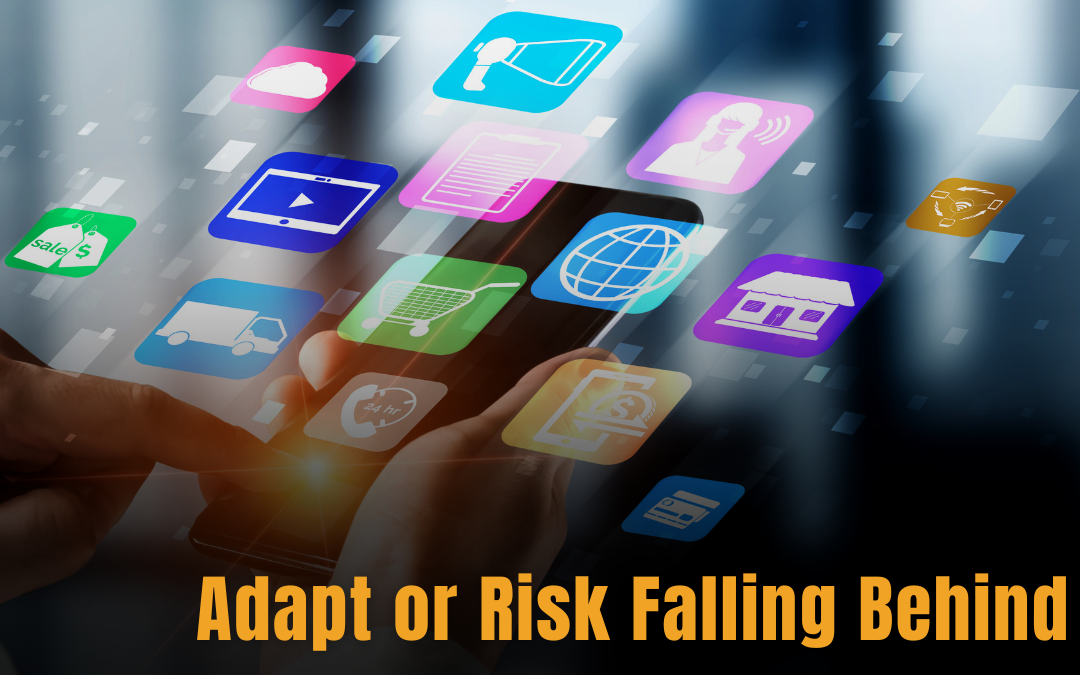 As 2025 approaches quickly, small businesses are facing a dynamic and rapidly evolving landscape forcing you to reconsider or redesign your business model. From technological advancements to economic uncertainties, the challenges that lie ahead are both exciting and daunting. To stay competitive and thrive, we must all be proactive in addressing the following top five concerns:
As 2025 approaches quickly, small businesses are facing a dynamic and rapidly evolving landscape forcing you to reconsider or redesign your business model. From technological advancements to economic uncertainties, the challenges that lie ahead are both exciting and daunting. To stay competitive and thrive, we must all be proactive in addressing the following top five concerns:
-
Digital Transformation and Technological Adoption
In 2025, digital transformation will be more critical than ever for small businesses. As technology continues to evolve at a rapid pace, businesses must embrace digital tools and platforms to stay relevant. This includes utilizing artificial intelligence (AI) and machine learning and enhancing their online presence and customer engagement strategies.
Why It Matters:
Small businesses that fail to adopt new technologies risk being left behind by competitors who can operate more efficiently and engage more effectively with customers. Digital transformation is not just about having a website or social media presence; it’s about integrating technology into every aspect of the business, from operations to customer service and marketing.
Key Considerations:
- Investment in Technology: Small businesses need to allocate resources for the latest technologies that can streamline operations, improve customer engagement, and provide data-driven insights.
- Training and Skill Development: Employees must be trained to use new AI tools and technologies effectively. Investing in training programs can help ensure that staff are comfortable with and capable of leveraging digital tools to their full potential.
- Cybersecurity: With increased reliance on digital tools, small businesses must also prioritize cybersecurity. Protecting customer data and sensitive business information is crucial to maintaining trust and compliance with regulations.
For example, here are five ways you can use AI to enhance your business operations:
-
Automating Customer Support with Chatbots
- AI-powered chatbots can handle routine customer inquiries, provide instant responses, and guide users through common issues. This not only improves customer service but also reduces the workload on human staff. This improves response times, enhances customer satisfaction, and allows human agents to focus on more complex tasks.
-
Personalizing Customer Experience
- AI algorithms can analyze user behavior on a website to offer personalized recommendations, such as suggesting products based on previous purchases or browsing history. This will increase customer engagement, boosts sales, and improves customer loyalty by creating a more tailored shopping experience.
-
Enhancing Marketing Strategies with Predictive Analytics
- AI can analyze large sets of data to identify trends and predict future customer behaviors. This allows businesses to create more targeted marketing campaigns and optimize ad spending. This improves marketing efficiency, increases conversion rates, and maximizes return on investment (ROI).
-
Streamlining Inventory Management
- AI can forecast demand based on historical sales data, seasonal trends, and market conditions. This helps businesses maintain optimal inventory levels, reduce waste, and avoid stockouts. This saves costs, improves supply chain efficiency, and ensures that products are available when customers need them.
-
Enhancing Website Performance and Security
- AI tools can monitor website traffic in real-time to identify unusual patterns that may indicate a security threat, such as a cyber-attack or fraud. AI can also optimize website speed and performance by dynamically managing resources. This protects sensitive customer data, reduces downtime, enhances user experience, and builds trust with customers by ensuring a secure and reliable website.
-
Economic Uncertainty and Financial Resilience
Overview:
Economic uncertainty is a perennial concern for small businesses, even though the Federal Reserve is planning a rate cut this fall, we could all still feel inflation significantly in 2025. The interest rate fluctuations, and potential economic slowdowns can impact material costs, shipping, labor and other business operations.
Why It Matters:
Financial instability can threaten the survival of small businesses, particularly those with tight margins and limited access to credit. Building financial resilience is essential to weathering economic storms and ensuring long-term sustainability.
Key Considerations:
- Diversification of Revenue Streams: Small businesses should explore multiple revenue streams to reduce dependency on a single source of income. This could include expanding product lines, entering new markets, or offering digital services.
- Cash Flow Management: Effective cash flow management is critical in uncertain economic times. Businesses need to have a clear understanding of their cash position and develop strategies to manage expenses and optimize receivables.
- Access to Capital: Maintaining strong relationships with financial institutions and exploring alternative financing options, such as crowdfunding or venture capital, can provide a buffer during economic downturns.


-
Changing Consumer Behavior and Expectations
Overview:
Retailers and ecommerce businesses must monitor consumer behavior closely in 2025. Factors such as increased demand for personalized experiences, sustainability concerns, and the growing influence of Gen Z consumers are reshaping the marketplace.
Who is the Gen Z buyer? Gen Z is the generation of people born between 1997 and 2012. They are the generation that comes after millennials and before Generation Alpha. Gen Z is changing buying behaviors in several ways, including:
- Prioritizing sustainability
Gen Z is more likely to buy from companies that are transparent about their supply chains and production processes, and that use sustainable materials and reduce their carbon footprint.
Gen Z values products that reflect their unique identity and values and are drawn to brands that offer customization and personalization.
Gen Z is more economical and price-sensitive than older generations and is less likely to make impulse purchases.
Gen Z prefers debit cards over other payment methods and is cautious about using credit cards.
Gen Z uses social media platforms like TikTok and Instagram to make purchases, as they offer trusted user reviews and comments.
Gen Z has an adventurous palate and embraces food that stimulates their senses.
Why It Matters:
Understanding and responding to changing consumer expectations is essential for maintaining customer loyalty and attracting new clientele. Small businesses that fail to adapt to these shifts risk losing relevance and market share.
Key Considerations:
- Personalization: Consumers increasingly expect personalized experiences, whether online or in-store. Small businesses should leverage data analytics to understand customer preferences and tailor their offerings accordingly.
- Sustainability: Environmental sustainability is becoming a significant factor in consumer purchasing decisions. Businesses that adopt sustainable practices and transparently communicate their efforts will be better positioned to attract and retain customers.
- Omnichannel Engagement: Customers expect seamless experiences across all touchpoints, from physical stores to online platforms. Small businesses need to develop robust omnichannel strategies to meet these expectations and deliver a consistent brand experience.
-
Talent Acquisition and Retention
Overview:
Attracting and retaining talent is a challenge that will continue to be at the forefront for small businesses in 2025. The rise of remote work, increased demand for flexible work arrangements, and a competitive job market make it difficult for small businesses to find and keep top talent.
Why It Matters:
Employees are a crucial asset to any business. Small businesses that can attract and retain skilled workers will have a significant advantage over competitors who struggle in this area. Additionally, high employee turnover can be costly and disruptive to operations.
Key Considerations:
- Flexible Work Arrangements: Offering flexible work options, such as remote work or flexible hours, can help attract a broader talent pool and increase employee satisfaction and retention.
- Employee Development: Investing in employee training and development programs can enhance skills, improve job satisfaction, and reduce turnover. Providing clear career progression opportunities can also motivate employees to stay with the company.
- Competitive Compensation and Benefits: Small businesses must ensure their compensation and benefits packages are competitive. This includes not just salary but also health benefits, retirement plans, and non-monetary perks like wellness programs and professional development opportunities.
Overview:
Navigating regulatory compliance is a growing concern for small businesses, particularly as laws and regulations become more complex. In 2025, issues such as data privacy, labor laws, and environmental regulations will require careful attention.
Why It Matters:
Non-compliance with regulations can lead to severe penalties, legal action, and reputational damage. Staying abreast of regulatory changes and ensuring compliance is essential for minimizing risk and avoiding costly mistakes.
Key Considerations:
- Data Privacy: With increasing consumer awareness and regulatory scrutiny around data privacy, businesses must ensure they are compliant with laws like the General Data Protection Regulation (GDPR) and the California Consumer Privacy Act (CCPA). This involves safeguarding customer data, obtaining consent, and providing transparency around data usage.
- Employment Laws: Changes in employment laws, such as minimum wage increases, overtime regulations, and employee classification rules, require small businesses to stay informed and make necessary adjustments to their policies and practices.
- Environmental Regulations: As sustainability becomes a more pressing concern, businesses may face stricter environmental regulations. Understanding these requirements and incorporating sustainable practices into operations can help businesses stay compliant and align with consumer expectations.
As you prepare for the challenges of 2025, it is crucial to remain agile, informed, and proactive. By addressing these top five concerns—digital transformation, economic uncertainty, changing consumer behavior, talent acquisition and retention, and regulatory compliance—you can position your business for success. Embracing change, investing in technology, and staying attuned to market trends will help businesses navigate the complexities of the modern business landscape and thrive in the years ahead.










